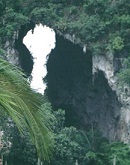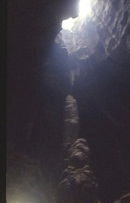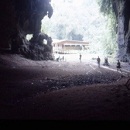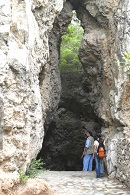NEW CAVES TO EXPLORE (Part two of three)by Harold Stephens
Travel Correspondent for Thai Airways International
When we travel about Thailand, we can't help noticing the strange outcroppings that rise up sheer from table-flat plains. They appear like huge fortresses, or castles; some may be many kilometres square; others no larger than a city building.
The formations, geologists tell us, are calcareous limestone rock in which, surprising as it may seem, many sea fossils have been found. The rock is about 400 million years old. Fossils show that the rocks were formed originally in the shallow waters of the warm sea. At some period in time the rocks were uplifted by volcanic thrusts and formed mountain ranges. For millennia, under the constant down-pour of monsoon rains, the soft alluvial soil has been washed down to the low lands and eventually out to sea, and what remained standing, like lone sentinels, were the outcroppings.
The caves themselves are the result of erosion within the formations, caused by rainwater and small streams and rivulets. It was no sudden upheaval that broke up the land mass but the meticulous work of nature, the slow process of wearing down the earth by sun, rain, wind and more rain.
These caves offered natural protection for early man. It was in such caves in northern Borneo that my first interest in these dark secrets of Southeast Asia began. They were the famous Niah Caves of Sarawak.
Although the Niah Caves were known as far back as the1870s--when an animal collector noted their existence--it wasn't until the1950s that they made world headlines. A curator from Sarawak Museum thought they might have some archaeological potential and began excavating. Sure enough, when he dug down 5 meters he found the skull of a young Homo sapiens who had lived in the caves 40,000 years ago. It was the earliest known remains of modern man in the this part of the world. As the museum delicately probed the layers of soft deposit, it unearthed the evolution of a human culture. Many agreed it was the greatest discovery since the Java Man.
Being hunters and food gatherers, early man did not spend all his time living in caves. He moved in the area round his cave and went there not only for shelter and protection but also to bury his dead, perform religious and mystical ceremonies and decorate these sanctuaries as holy places. Cave walls which have been preserved under hundreds of metres of guano are time capsules waiting to be opened one day to reveal our past. Some remarkable and mysterious cave drawings have been found.
The author of The Arts of Thailand, an excellent documentation of the history of Thai art, stated that we can safely say the caves of Thailand are the country's first museums of modern. "On limestone walls," he continues, "Stone Age artists drew ochre and black stick figures as well as full-bodied humans and animals cavorting in empty space. In these primitive landscapes, birds, tortoises, frogs and herds of cattle appear at random, often overlapping one another without regard to the others' right of prior domain. Perhaps the artists drew in light so dim they could not discern the outlines of figures previously sketched there."
Some of these murals, like the ones found in the Viking Caves on Pee Pee Lay Island in southern Thailand, have baffled archaeologists and travellers ever since they were discovered. Blanketing a length of wall about 30 feet long and six-to-eight feet high, the drawings—painted with different shades of clay—show a disjointed fleet of ships.
Size and design vary from junks with pleated sails to galleons sporting row of oars. Some appear on the verge of collision or battle, others sail alone in shadowed corners.
Some believe they might be a vivid portrait of what might have been pirate practices in the past. Others concluded that there is nothing esoteric about them at all. It so happened that the many caves is this area contain one of the world's most expensive and rare delicacies, swifts' nests, used for making Birds' Nest Soup. The islanders say the gathering of bird nests has been going on for hundreds of years. This may be a key to the mysterious cave drawings. Could not the drawings have been made by dutiful nest protectors, bored with the endless months of cave living, and their wall dabblings are nothing more than graffiti?
Another story that can trigger the imagination is the drawings were left by alien visitors. It all depends upon which you want to believe.
Other such paintings on the walls of a limestone cave on Koh Khian Island in Phang-nga Bay, a short distance from Viking Cave, are thought to date from prehistoric times. They are devoted to figures of animals and abstract patterns.
In time caves became holy shrines. Since the earliest days of Buddhism in India, caves have been utilized as temples, partly because of the protection they offered, but partly too for their mystical atmosphere.
Buddhists were not alone. Hindus had turned to caves for places of worship centuries ago and brought the practice with them to South-east Asia when they arrived in the 9th century. The most famous of these Hindu holy shrines is Batu Caves north of Kuala Lumpur. During their most recent Thaipusam festival, a record 400,000 Hindu devotees gathered at Batu Caves to pay respect to their gods by piercing their bodies with spikes and skewers.
On the East Coast of Malaysia I found, quite by accident, another religious cave of sorts that truly threw me off guard. I was searching for an underground tin mine, reputed to be the deepest in the world, when I became hopelessly lost.
It was mountainous country, thick with jungle except for patches that had cleared for rubber plantations. The road, no more than a track, led from one dusky plantation to another. At one plantation a tapper informed me I was on the wrong road; the one I was on lead to Panching Caves, where the Thai Buddhist monk lived. This sounded much more interesting than a tin mine. I continued on the same road.
Forests of rubber trees closed around me. The plantations were very old, with tired trees covered with canker and mould. Suddenly the road came to an end. A limestone cliff rose up before us, without warning. It appeared from nowhere. When I stepped from the car and looked upwards, the mountain seemed to have no top, but part way up the side of the cliff there was a ledge with a railing. A monk in his saffron robe heard us coming.
He was leaning over the railing, pointing to a rickety stairway.
It was a bit of awkward climbing to reach the ledge. The monk, an elderly gentleman, introduced himself--Than Acham Sakatapunya--and bid me to be seated. He offered me tea and told me how he had come to the Pahang jungle many years before. He had a small shrine with the image of Buddha under a rock overhang. He was pleased that I had come to visit. After some time I thanked him and began to leave. He gave me a startled look. Didn't I want to see the cave?
What cave! Wasn't this, the rock overhang, his cave?
The monk waved a hand and a young Malay boy appeared. He motioned for me to follow him up a second set of stairs, even more precarious than the first. We came to the entrance of a large deep cavern and cautiously worked our way in. Suddenly looming up before us was a giant statue of a reclining Buddha, more than ten metres long.
Here was the life's work of a lone Thai monk. How many years of unending labour, carrying sacks of cement and sand and building material up the face of the cliff, how many years did it take to construct this noble monument? How many more such unknown caves are there in Thailand?
Malaysia was only a forerunner of the caves to come in Thailand.
Continued next week.
Harold Stephens
Bangkok
E-mail: ROH Weekly Travel (hstephens_1@yahoo.com)
Note: The article is the personal view of the writer and does not necessarily reflect the view of Thai Airways International Public Company Limited. | 
Not all entrances are in the open | | 
Many caves are deep and spooky | | 
| | 
Some openings are grand | | 
Prehistoric psintings on cave walls | | 
For more about caves |
|





